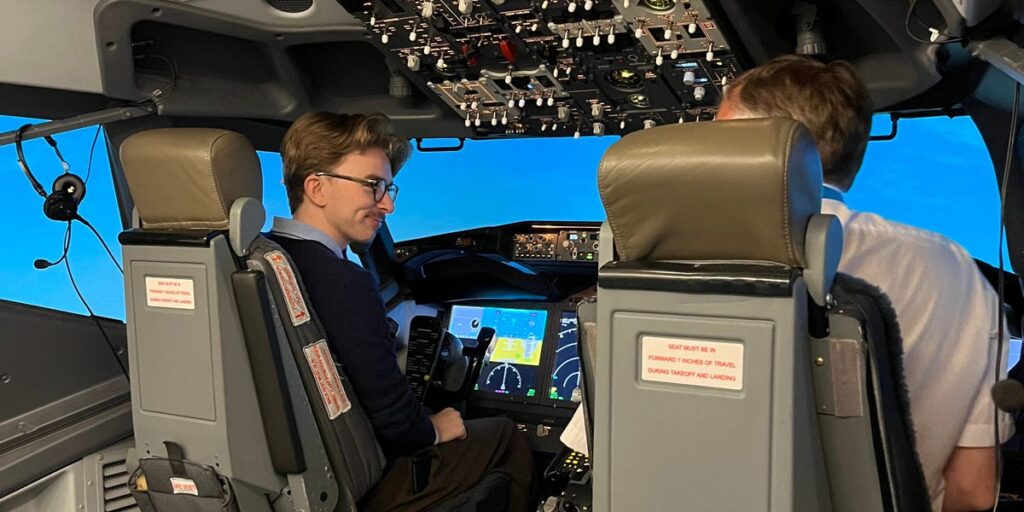- I visited Skyborne, a flight academy in England where wannabe airline pilots train.
- I tried out two flight simulators, including one for a Boeing 737 Max.
- I got mixed up with the instruments and found the low-visibility landing daunting.
I write about planes nearly every day at Business Insider, but trying out a Boeing 737 Max flight simulator gave me new insights into just how much skill and dedication is required to be a pilot.
In late September, I visited Skyborne, a pilot training academy based at Gloucestershire Airport in England. Its 18-month course costs £105,500 ($140,000).
I started off with a simulator for the Diamond DA42 — the same twin-engine propellor plane in which Skyborne cadets take to the skies during multi-engine training.
The classroom was dark, with the view projected onto a curved wall in front of the replica cockpit. I was helped along the way by Matthew Yemm, a Skyborne flight instructor who spent a decade in the Royal Navy.
Getting to grips with the basics was relatively simple: left hand on the stick, right hand on the thrust levers.
With the Gloucestershire Airport runway projected in front of us, takeoff went smoothly — largely thanks to Yemm guiding me through the throttle and helping keep the jet on the centerline.
It was a strange feeling guiding the stick with my left hand as I practiced some sharp turns. At one point, the steep angle triggered an alert — but not to the extent that I lost control. If it were a real plane, I probably would’ve panicked hearing that beep.
Flying the 737 Max
The more imposing simulator was that of a Boeing 737 Max. It proved harder than I imagined, even with an expert pilot by my side.
Nick Heard, Skyborne’s manager of multi-pilot training, spent 16 years in the UK’s Royal Air Force followed by 17 years flying Boeing 747s with Cathay Pacific.
In this classroom, the simulator was large, gray, and peculiarly shaped: imagine half a sphere stuck to the back of a portacabin.
Yet once I was in the captain’s seat, it felt just like the real thing: a flight deck with sheepskin-covered seats and myriad switches.
Thankfully, I didn’t need to learn what all the bells and whistles did. At first it seemed simple, but only because we were flying with autopilot during the day.
Heard would read out a heading — the compass direction for the plane — and I only needed to turn a knob to let the computer direct it accordingly.
This communication gave me a taste of how Skyborne utilizes the 737 Max simulator for cadets to learn how to work with others as part of the Airline Pilot Standards Multi-Crew Cooperation Course (APS MCC).
Autopilot can do almost everything, but it’s enthralling to experience the magic yourself.
However, with control in my hands, I started to get confused.
Heard had me pay attention to the flight deck instruments. The flight director, a pink cross, showed me where I needed to direct the plane — represented by a black dot.
But I soon got mixed up, forgetting which graphic I was supposed to be directing and which one I was following. In my haze, it was as if I was playing a video game with the inverted controls setting mistakenly activated. I felt myself sweating.
I asked Heard to remind me how I was supposed to follow the screen and soon found myself back on course.
Even without my confusion, it wasn’t easy. The 737 yoke wasn’t as mobile as the DA42’s stick. I found it required a bit of effort to move, but the motions could then be quite sudden.
After I got the hang of it, Heard changed the simulator settings to nighttime. The English countryside below was replaced by blackness, bar a few lights on the horizon.
We finished the session with an ultra-low-visibility landing, following the flight instruments toward the runway.
The computer’s eerie voice counted down the altitude, and still, there was nothing but a dark fog. Nothing but darkness before we were 100 feet above the runway, and its white lights shot into view beneath us.
I only had a few seconds before it was time to use the pedals. The lower part controlled the rudder to maintain the runway’s centerline, while I also needed to use my toes to brake.
I was close to veering off the runway before Heard assisted me with his pedals, while pointing out that the passengers would’ve been frustrated by my sudden braking.
Leaving the simulator, I was out of sorts for a moment. The classroom’s bright lights reminded me it wasn’t actually the middle of the night. After watching the screens outside the cockpit window, it took a moment to find my feet again.
As we were flying during the night, Heard’s words helped me comprehend the difficulty of being an airline pilot. He explained how this is what much of the day-to-day job can be like — coupled with jet lag and a lack of sleep.
I had a lot of fun, but I’d certainly struggle with changing time zones as frequently as an airline pilot, let alone going through 18 months of training and perfecting how to control an aircraft.
Read the full article here


